Suggested Reading:
 Tomorrow’s Wonderful World – An Inside View!
Tomorrow’s Wonderful World – An Inside View!
While the world focuses on a potential nuclear showdown with Iran, an internal crisis of a different nature is gripping the Persian nation.
Subscribe to the Real Truth for FREE news and analysis.
Subscribe NowSince becoming president of Iran in August 2005, Mahmoud Ahmadinejad has been vocal on the world stage, making endless inflammatory remarks. Never mind the number of fiery comments he directed toward the United States. Perhaps two of his most controversial statements are the claims that the Israeli regime must be wiped from existence and that the Holocaust is a myth—creating a firestorm the world over.
In defending his nation’s nuclear aspirations, Mr. Ahmadinejad asserts that Iran desires nuclear technology for peaceful energy purposes.
But the nations of the West view this as fiction. They believe Tehran is seeking nuclear weapons, and the White House has firmly declared that the U.S. will pursue whatever means necessary (stopping short of using the word “war”) to prevent Iran from developing nuclear technology.
Mr. Ahmadinejad, on the other hand, has stated numerous times that Iran will defend, at all costs, what it feels is its inherent “right.”
As mainstream news media outlets bombard citizens of the West with countless stories of potential war with Iran, even painting a picture of rampant Islamic extremism in the nation, the average Westerner associates Iran with nuclear bombs, war, religious fanaticism and death-chanting Islamic militants. Most might even conclude that all Iranians are bent on the destruction of the West, particularly the United States and Israel, since this appears to be Tehran’s position. More than once their president has referred to America as “the great Satan.”
For many, a military confrontation looms just over the horizon, with the drumbeat of war growing louder and louder.
Yet within Iran’s borders, a storm is brewing—of which few outside the country are aware.
In December 2006, a notable crowd of Iranian students participated in an event called “University is Alive.” They chanted, “Nothing to lose but our chains!” “Death to dictators!” “We want bread, not bombs!” This demonstration occurred despite the government’s tough measures on political dissent.
Elsewhere, as Iran’s president delivered a speech at Amirkabir University, students heckled him and set his picture on fire.
A “war of words” is spreading among Iran’s youth, with talk of “change” and “revolution.”
Within the last 75 years or so, the people of Iran have lived under two vastly different forms of governance.
Prior to the 1979 Islamic Revolution, Iran existed as an autocratic, pro-West monarchy, ruled by a Shah (the title of the hereditary monarch). Mohammad Reza Pahlavi, the Shah from 1941-1979, maintained good relations with the American government. However, his policies conflicted with traditional Muslim views on alcohol, gambling, premarital sex, and other social taboos he refused to ban. The Shah faced continual opposition from religious figures (who were generally poor) and the urban middle-class who did not benefit from his extravagant lifestyle.
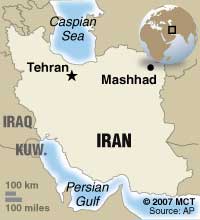
The poor and middle-class, who constituted a majority of the population, opposed the Shah’s efforts to bring about modernization—in effect, they opposed being Westernized. Instead, they yearned for a return to an Islamic lifestyle, which is at odds with the decadent lifestyles now found in every Western country. The Shah’s reforms were viewed as self-serving, and his march toward “progress” was seen as a lie, based on the huge gap between rich and poor.
In time, religious leader Ayatollah Khomeini led an opposition movement, speaking out against the monarchy and claiming that the Shah’s reign was tyrannical. This led to Khomeini’s exile in the early 1960s.
After the Shah was removed from power in January 1979 and forced to flee the country, Khomeini was welcomed back into Iran and later given the newly created office of “Supreme Leader” (or “God’s Representative on Earth”), a role that an individual would retain for life.
The world’s first theocratic Islamic government was taking shape.

In his first address to the people of Iran, Ayatollah Khomeini stated, “Muhammad Reza Pahlavi…fled stealing everything. He ruined our nation and filled our cemeteries. He ruined our country’s economy. Even the projects he carried out in the name of advancement pushed the country toward decadence. He suppressed our culture, destroyed people and ruined all our manpower resources.”
In contrast to this picture, the new Supreme Leader promised a type of Islamic paradise on earth. Among other things, he assured all would enjoy independence, and that there would be an Islamic classless society. The nation’s wealth would be distributed equally, so all would be financially equal. There would be free electricity, free water and free transportation for everyone, to be paid for by the nation’s vast oil revenues. The Ayatollah was deemed the “leader of the world’s underprivileged.”
Along with these promises came Sharia law, or law based upon Islamic principles.
After the monarch was removed from power, much disagreement ensued over how and by whom Iran should be governed. Liberal, secularist, Marxist, anarchist and religious groups were eager to seize authority over the country.
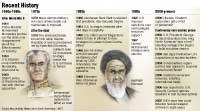
Initially, two groups were in control: a liberal secular group named the Freedom Movement and an Islamic Republic party comprised of clerics led by Ayatollah Khomeini. Tension grew between the two.
In June 1979, the Freedom Movement introduced a draft constitution that declared Iran an Islamic Republic. But the constitution failed to give precedence to Sharia law. When it was sent to the legislature, which was dominated by supporters of Ayatollah Khomeini, it was rejected.
Eventually, a new constitution based solely on Islamic law was drafted. It is this law that has become an issue of intense contention among young Iranians.
It has been nearly three decades since the Islamic Revolution. Although those who lived through it are now in the minority, nearly every Iranian is aware of its significance. The revolution was supposed to be a monumental turning point in the nation’s history, one that was to bring change for the better.
But Iranians, especially those under age 30, who constitute 70% of the population, are beginning to resent the Islamic government that the previous generation wholly embraced. They are growing to despise the rules and regulations being imposed (sometimes with force) upon them. They are tired of a religious system that governs every aspect of their lives. Large numbers are speaking out against what they view as oppressive and restrictive laws limiting their “freedom.”
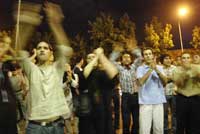 MCT
MCT
Calls for yet another change in government are ringing ever louder. And the Internet “blogosphere” has become the medium of choice in voicing dissent.
In late 2001, a young Iranian journalist created one of the first weblogs, or “blogs,” in Farsi (the most widely spoken Persian language), and eventually taught others how to create them. Today, Farsi blogs have mushroomed in popularity, surpassing the number of Spanish, German, Italian, Chinese or Russian blogs existing today. A 2004 NITLE Blog Census reveals that there were more than 64,000 Farsi weblogs, most emanating from Iran—staggering numbers, especially considering that neighboring Iraq had less than 50 bloggers.
Iranians are turning to blogs at increasing rates for a number of reasons, but mainly because blogs have provided a safe medium to freely voice opinions on a wide variety of topics, especially the government and its effect on life in Iran. Unlike the nations of the West, in Iran one cannot freely voice opposition to the government. Doing so means risking imprisonment—even death! In the past decade, the Islamic regime has shut down more than 100 print publications, 41 of which were daily newspapers, and has thrown a number of journalists into prison.
This is in stark contrast to what bloggers recall Ayatollah Khomeini saying in 1978: “In Iran’s Islamic government the media have the freedom to express all Iran’s realities and events, and people have the freedom to form any form of political party and gathering that they like” (Paese Sera, November 2, 1978).
Even weblogs, however, are not untouchable by the government. In 2003, Iran became the first country to imprison a blogger. Since then, many more have been arrested.
Still, the anonymity of the blogosphere means it is the safest avenue to voice political opposition, since one does not need to provide his or her name. This makes it difficult for authorities to track down specific bloggers.
The following statement written by an Iranian blogger perhaps best summarizes the view of most of Iran’s younger, Internet-savvy generation: “The…killings at the dawn of the Revolution, the assassination, eight years of devastation and war, the bombing of towns, the…killings of prisoners en masse in the 1980s [are] all the bloody roots of our story. Yet today these blood feuds are fading from the minds of a new generation…A generation that was created for martyrdom is suddenly aware of its predicament and the world around, and no longer believes in the endless wars of its forefathers. A new generation is pressing forward to destroy the old formula” (New Internationalist).
Even those who profess to be religious are speaking out. A notable Islamic scholar stated that 25-plus years of Islamic rule “has not made Islam stronger, but it has brought about a decline in the position of the clergy and religion in society” (ibid.).
Due to the Iranian blogging phenomenon, outsiders are able to view Iran in a new light. Before the advent of Farsi blogs, they were generally forced to rely upon stories and images coming straight from the Iranian regime. A former Guardian correspondent who was expelled from Iran said, “Stifling the flow of information means that the nuances of Iranian society are often obscured to the outside world. Any foreigner who visits Iran is struck by the gap between the reality of society and the image cultivated by the regime” (Guardian, May 24, 2004).
Many Iranians look favorably toward America, mostly due to a desire to have all the freedoms that America’s citizens enjoy. After visiting Iran in 2004, a New York Times columnist commented, “Finally, I’ve found a pro-American country” (We Are Iran, by Nasrin Alavi).
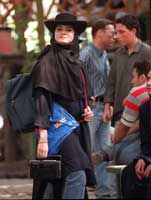 MCT
MCT
Virtually everywhere he traveled, the Iranian people he encountered were “exceptionally friendly and fulsome in their praise for the United States, and often President Bush as well,” adding that being pro-American in Iran “is a way to take a swipe at the Iranian regime.”
The columnist also said, that based on his stay in Iran, there is a better “chance of a strongly pro-American government in Tehran in a decade than in Baghdad.”
Surprising to some, after the infamous 9/11 terrorist attacks, there was strong sympathy in Iran for Americans. For instance, “On the evening of September 11, 2001, young people gathered in Madar Square, on the north side of Tehran, in a spontaneous candlelight vigil to express sympathy and support for the United States. A second vigil, the next night, was attacked by the Basij, a volunteer force of religious vigilantes, and then dispersed by the police. The vigils may have been the only pro-American demonstrations in the Islamic world after the terrorist attacks on the United States” (The New Yorker).
Yet one must not conclude that Iranians are entirely pro-American; there is some reservation in their thinking. Many recall the 1953 American-British coup that overthrew the democratic Iranian government led by Dr. Muhammed Mossadegh. A Central Intelligence Agency report published by The New York Times in 2000 confirmed what Iran had known for a long time: The coup garnered an intense and long-lasting hatred for the U.S. and Britain, which has only recently subsided among Iran’s population.
Dr. Mossadegh is still highly regarded by those pushing for democratic reform. On what would be his birthday, it is common for bloggers to commemorate his life and lament over what could have been—a true Iranian democracy.
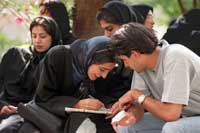 MCT
MCT
Today’s young Iranians are caught in a conflict between tradition and globalization. Satellite television and the Internet have allowed outside influences to enter Iran as never before. A whole new world has become visible.
Traditional Islamic culture and values are being challenged by what Iranian officials call a “cultural onslaught” from the West. Shielding the youth from Western culture has led to intense curiosity and a desire to embrace it.
A veteran journalist commented, “Many Iranians, even those on very limited incomes, own illegal satellite dishes that give them instant access to American television. CDs, videos and computer programs are pirated and sold on the streets for a fraction of their price in the United States. Email is more widely available in Iran than in many other Middle Eastern countries” (Persian Mirrors, 2000).
After nearly 30 years of Islamic rule, the goal of creating Islamic “model citizens” who willingly and wholeheartedly adhere to cultural dress and moral codes has all but failed. Interestingly, a society that was at one time willing to fight for its cultural identity is now extremely receptive to outside traditions.
Instead, young people in droves are embracing Western influences, including even Valentine’s Day. The nation has become almost overrun with this once foreign holiday, and it is a subject of much debate among the Iranian press. Numerous references to this day are found throughout Iranian blogs on February 14.
In February 2004, Sharg newspaper reported, “Valentine’s Day or as they say the Day of Lovers, a totally Western tradition, is gradually entering the hearts of the youth of the East. Just a glance at the shops scattered around town selling presents for this European celebration and you can grasp the reality” (We Are Iran).
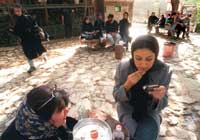 MCT
MCT
To help combat this “foreign invasion” of Western influences, Iran’s Morality Police wander the streets enforcing the cultural rules of the regime. Alcohol, dancing, make-up, pop music and holding hands in public, to name a few, are strictly forbidden. Traditional skin- and hair-covering dress for women is mandatory.
In 2002, the Morality Police were strengthened by “Special Units,” adding to the already-large number of individuals who enforce public morality and fight against “social corruption among the youth.”
Yet a growing sentiment is that it is next to impossible to suppress the youth culture. As a result, young Iranians have been granted some little reprieve from cultural mandates—but still not close to the full freedom they would like.
Calls for democracy are ringing across Iran. Calls for freedom are echoing loudly. A desire for change is stronger than ever.
What if democracy came to fruition in Iran? What if the freedom young Iranians yearn for were given to them? Would they experience a utopian existence? Or is theirs a case of “the grass is greener on the other side” mentality?
While all governments of men, especially democratic ones, promise “pie in the sky” success, they are all filled with graft, corruption, immorality and every form of deception. Political infighting and division of every kind abound.
In democracies, there is freedom to live and act as one pleases, which appeals to those living under a totalitarian government that dictates every aspect of life. But this so-called freedom, which gives license to rampant immorality, leads to shallow lives and everyone doing what is right in his own eyes. Right and wrong becomes blurred by “individual expression” and the “right” to live one’s life as he or she desires. Lawlessness sets in. Degeneracy and vileness of every imaginable sort take over.
The democracies of the West serve as prime examples.
Government by the people means that everyone has a voice, with many advocating their view of right and wrong. A society that has nearly unlimited freedom ultimately loses its freedoms. Why? Because eventually the majority wins and forces its view upon others. The freedoms that were sought become lost. A government once yearned for becomes despised.
The liberty and utopian existence that young Iranians seek cannot be achieved by a democracy. In fact, no government in the hands of men can provide true and lasting freedom.
However, there is a government that can—and will!—bring this, and it is on the horizon. To learn more, read our book Tomorrow’s Wonderful World – An Inside View!